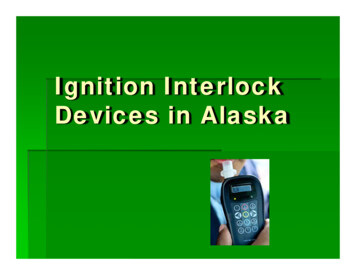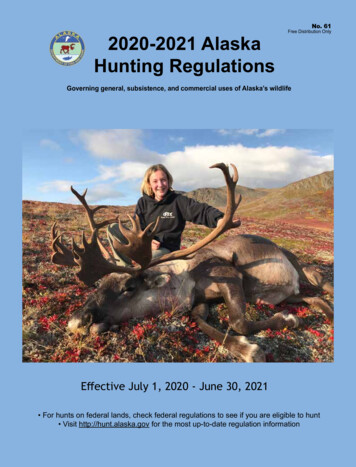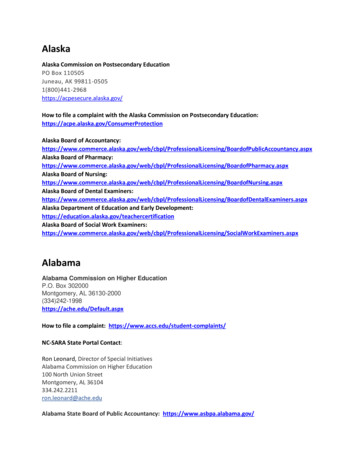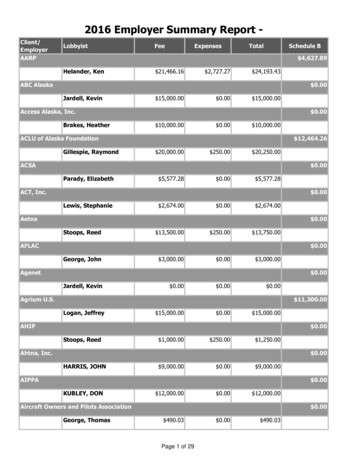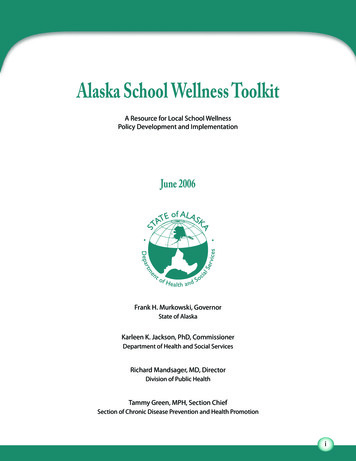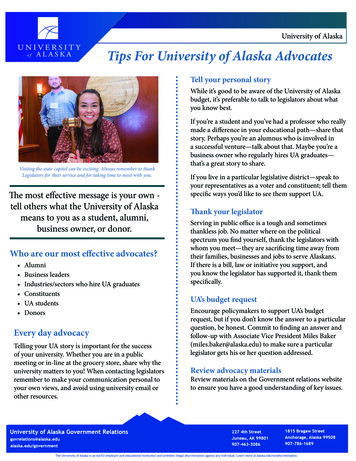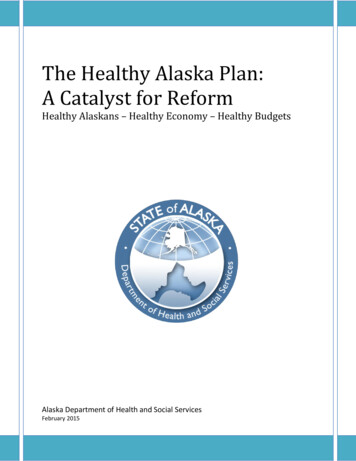
Transcription
The Healthy Alaska Plan:A Catalyst for ReformHealthy Alaskans – Healthy Economy – Healthy BudgetsAlaska Department of Health and Social ServicesFebruary 2015
“This evening there are tens ofthousands of Alaskans with nohealth insurance who could becovered at no cost to the state.These are mothers and fathers,sons and daughters; entirefamilies who will go to bedtonight in fear. Fear that despitetheir best efforts, they are justone injury or diagnosis awayfrom losing everything. That’swrong. It’s unacceptable. Andwe’re going to put an end tothat on my watch.”Governor Bill Walker, State ofthe State address, January 2015
Department ofHealth and Social ServicesOffice of the Commissioner3601 C Street, Suite 902Anchorage, Alaska 99503-5924Main: 907.269.7800Fax: 907.269.0060February 6, 2015Dear Alaskans,Governor Walker and I have heard from so many Alaskans about their inability to get the healthcare they need. We all have an interest in ensuring that Alaskans are as productive as possibleand can contribute to our communities and economy. But people can’t work, hunt, or fish whenthey are not healthy.Medicaid expansion is our opportunity to invest in the health of Alaskans and the health of oureconomy. Over 41,000 of our family members, friends and neighbors have the opportunity forhealth coverage.Medicaid expansion will serve as a catalyst for meaningful Medicaid reform. Leveraging thefederal resources that come with expansion is our biggest opportunity to finance our reformefforts.I look forward to working with Alaskans to redesign our Medicaid system to meet our currentfiscal challenges while ensuring that our most vulnerable Alaskans have access to wellness andprevention programs.Quyana (thank you).Valerie DavidsonCommissionerDepartment of Health & Social Services
This page is intentionally blank
The Healthy Alaska Plan: A Catalyst for ReformTable of ContentsThe Healthy Alaska Plan:I.Healthy for Alaskans . 2II. Healthy for the Economy. 6III. Healthy for the State Budget. 7IV. Catalyst for Reform . 9End Notes . 12GOALS FOR IMPROVING HEALTH CARE IN ALASKAThe Walker/Mallott Transition Team recommended the following goals for improving health care inAlaskai: Implement Medicaid expansion without delay as a catalyst for Medicaid reform Maximize federal revenue and minimize unrestricted general fund expenditures Recognize that those eligible for Medicaid through expansion can move to self-sufficiency Engage interagency and interdepartmental collaborations to leverage human and financialresources Ensure the transparency of data and information Decrease the percent of state residents without health insurance Hold increases in the cost of healthcare to the rate of inflation in Alaska Increase the number of healthcare providers in AlaskaThe Healthy Alaska Plan1
The Healthy Alaska Plan: A Catalyst for Reform, serves as the path to Medicaid expansion and thereform efforts for the State’s current Medicaid program. This report outlines how Medicaid expansionfunctions as the catalyst for meaningful Medicaid reform. This report includes the benefits for our fellowAlaskans who would gain access to health care coverage with expansion, as well as the positive impactsto Alaska’s economy and the associated savings to the State budget.I. Healthy for AlaskansMany low-income Alaskan adults will be able to access health coverage through Medicaid expansion.Currently, adult Medicaid is limited to residents who must not only be low-income, but also be in acertain category such as disabled, pregnant or caretakers of dependent children. The importance ofaccess to health care cannot be understated.Access to health care means improved health outcomes and increased productivity and independence.With Medicaid expansion: The number of uninsured Alaskans would be reduced by half;ii More Alaskans would receive preventative and primary care, including behavioral healthservices and help in managing costly chronic diseases; Business owners would benefit because of less turnover and fewer lost work days due toemployees with unattended illnesses and injuries; and, Alaska’s statewide mortality rate would drop.iiiThe bottom line is — health care coverage saves lives. A recent analysis of the impacts of healthinsurance coverage was conducted by health economists at Harvard University comparing mortalityrates for adults in Massachusetts for the five years prior to and five years following the date healthreform took effect in that state, versus a control group with similar demographics and economicconditions. The analysis found that for every 830 adults who gained health insurance, one death peryear was prevented.ivAccess to health care coverage means Alaskans will receive more preventative and primary health carethat can prevent death, disability and costly health services. v, vi Uninsured adults are less likely than insured adults to receive preventive services or screening,such as mammograms, Pap smears, or prostate screening. Inadequate prevention and screening increase the likelihood of preventable illness, misseddiagnoses and delays in treatment. Chronic diseases — such as cancer, heart disease, stroke, arthritis, asthma, diabetes, andbehavioral health conditions — are among the most prevalent, costly, and preventable orcontrollable of all health problems.The Healthy Alaska Plan2
The five most common causes of death in Alaska are cancer, heart disease, unintentionalinjuries, stroke and chronic lower respiratory disease. Of those, four are either preventable ortreatable if caught early (cancer, heart disease, stroke, COPD). In 2014, diabetes was the seventh leading cause of death in Alaska — 106 Alaskans died fromdiabetes mellitus.Health care access also helps address some of Alaska’s most pressing social issues. For our prisoner and parole population, access to behavioral health care, including substanceabuse treatment and mental health services, reduces offender recidivism.vii Alaska leads the country in high rates of domestic violence and sexual assault. Many survivorsdo not have health coverage, or lose it when they leave their abuser. Improved health careaccess through insurance coverage will make a positive difference in health behaviors andoutcomes for victims of domestic violence and sexual assault in Alaska. Access to Medicaid coverage is already showing a positive difference for the homelesspopulation in other states. According to a recent Kaiser Family Foundation report, Medicaidexpansion is contributing to improved access to care as well as broader benefits for homelessindividuals, such as the improved capability to gain employment.viiiAccess to health care and insurance coverage impacts everything from prevention of disease anddisability, quality of life, life expectancy, and the ability of people to work and become self-sufficient.WHO WILL BE ELIGIBLE FOR COVERAGE THROUGH EXPANSION?Medicaid expansion will increase access to health insurance for an estimated 41,910 low-incomeAlaskans.ix These are adults from 19 to 64 years of age who are currently not eligible for Medicaid —those not caring for dependent children, not disabled or pregnant, and who earn at or below 138% ofthe Federal Poverty Level (FPL) for Alaska. The Alaskans who will be eligible for Medicaid through theexpansion live in all areas of the state.Geographic Distribution of AlaskansEligible for Medicaid through ExpansionThe Healthy Alaska Plan3
Those in the expansion population include individuals who are not currently offered affordable healthinsurance coverage by their employer, may not be eligible for subsidized plans on the Health InsuranceMarketplace, and cannot afford to purchase an individual health insurance plan on their own.Expansion will benefit single Alaskans without dependent children earning up to 20,314 a year, andmarried couples without dependent children earning up to 27,490 per year. Once these Medicaidrecipients in the expansion population achieve a higher income they will be able to transition to theHealth Insurance Marketplace and receive a subsidy to help afford coverage until their income reaches400% FPL.Nearly 20,100 of those eligible are expected to enroll in the first year of expansion, increasing to over26,500 by the year 2021. Many are employed. Those who are unemployed are Alaskans who are notcurrently working but are looking for work, and include seasonal employees not currently working.Those identified as not in the labor force have no job and are not currently seeking employmentbecause they are retired, in school, have family responsibilities, are incarcerated, or have othercircumstances that preclude them from seeking employment.Employment Status of Alaska'sMedicaid Expansion PopulationUnemployed29.8%Employed43.8%Unable toWork5.5%Not in theLabor Force21.0%The Healthy Alaska Plan4
Approximately 24,000 of Alaskans (55% of the expansion population) have an annual income below100% FPL. People earning less than 100% FPL do not qualify for a subsidy to purchase health insurancethrough the Health Insurance Marketplace and fall in “The Gap” for access to coverage.Income Eligibility for Health CoverageThe Affordable Care Act limits eligibility for subsidies to those with incomes between 100% and 400%FPL. The Act as passed by Congress in 2010 required states to expand Medicaid eligibility as a conditionof participation in the Medicaid program, providing guaranteed access to coverage for these lowestincome Americans. However, a ruling by the U.S. Supreme Court in 2012 made Medicaid expansionoptional for states. The result of this court decision left low-income Americans earning less than 100%FPL who live in states that did not expand Medicaid eligibility in “The Gap.” This means they are noteligible for Medicaid and are also not eligible for a subsidy to purchase health insurance.The Healthy Alaska Plan5
II. Healthy for the EconomyAlaska is currently facing a serious fiscal challenge. The rapid and steep decline in oil prices not onlyaffects state government revenue levels, but has a ripple effect throughout our petroleum-dependenteconomy. At this time, when our state economy is particularly threatened with a potential recession,additional federal revenue and the accompanying job creation could help cushion the blow until oilprices begin climbing again and our economy stabilizes.Medicaid expansion will bring more than one billion new federal dollars into Alaska’s economy over thefirst five years, and create 4,000 new jobs.x The benefits of expansion will affect all populations, regionsand sectors as measured in improved health, job opportunities and short and long term medical carecost savings. By expanding Medicaid, the state will make a vital investment in Alaskans and Alaska whilepaving the way to meaningful Medicaid reform.Studies project that over the next seven years Medicaid expansion in Alaska would likely yield:xi, xii 40,000 uninsured Alaskans eligible for basic health care coverage 1.1 Billion in new federal revenue for Alaska 4,000 new jobs 1.2 Billion more in wages and salaries paid to Alaskans 2.49 Billion in increased economic activity throughout the stateMoreover, accessing these federal funds that our economy needs and Alaskans are due corrects aninequity in federal policy. The federal Medicaid expansion policy benefits Americans living in certainstates, the expansion states, at the expense of those Americans living in non-expansion states.Expansion will bring Alaska tax dollars back to Alaska and drive needed economic activity across thestate.Expanding Medicaid also helps reduce State general Fund expenditures because the federal funds willcover certain health services the state currently provides with general fund dollars. For example, theAlaska Department of Corrections is obligated to provide health care for incarcerated individuals anddoes so with State general fund dollars. Under expansion, federal Medicaid funds would pay for someof those services and save the state an estimated 4.1 million the first year and about 7 million eachyear following. This and additional areas of state savings are explained further in the next section.Another challenge for Alaska’s economy and Alaskan employers is the high price of health insurancepremiums and the underlying prices for medical services in our state. One driver of higher prices isuncompensated care, which is care provided for individuals who are unable to or otherwise do not paytheir medical bills. These unpaid bills translate into higher prices for commercially purchased healthinsurance and for self-insured employers. Arizona hospitals reported a decrease in uncompensated careof 31% during the first four months after Medicaid expansion was implemented there.xiii In 2011,Alaska non-tribal hospitals provided 91 million in uncompensated care. A significant drop in the levelof uncompensated care similar to Arizona’s experience could assist in controlling health care costgrowth in our state.The Healthy Alaska Plan6
III. Healthy for the State BudgetIt may seem counterintuitive that giving more people health care will result in state budget savings, butthe new federal revenue that comes with expansion enables savings of state general fund dollarscurrently obligated in other programs. These savings completely offset the state’s share of theassociated administrative costs and enable additional general fund reductions.MEDICAID EXPANSION GENERATES NEW REVENUE AND SAVES STATE MONEYProviding access to health care for more Alaskans will both improve the quality of life for thousands ofAlaskans while increasing state revenues and generating savings to the state general fund.In FY 2016, the State of Alaska has the opportunity to provide access to health care coverage for over41,000 Alaskans while reducing the general fund budget by 6.1 million.Not all 41,000 potentially eligible Alaskans are expected to enroll in Medicaid. People don’t enroll for anumber of reasons: they don’t think they will need health care; don’t want to sign up with thegovernment; or just never get around to it. During the first year of expansion, over 20,000 people areexpected to enroll, with the number increasing each year before leveling at about 63% of eligibleAlaskans, or nearly 27,000 enrollees.xivIncrease in Enrollees and RevenueCurrently, the federal government funds 50% of most Medicaid expenses. Under expansion, the federalgovernment will pay Alaska 100% of the health care expenses associated with the newly coveredpopulation for calendar years 2015 and 2016. The federal government will then transition its matchover several years to 90% of health care expenses for the new population. Starting in 2020, the federalmatch remains at 90%. The state is not required to continue the expansion coverage beyond the 90%match.201620172018201920202021New Enrollees20,06623,27326,49226,53526,58026,623Cost Per Enrollee 7,248 7,495 7,752 8,018 8,293 8,433--------------------------------------Costs Below are in Thousands of Dollars-------------------------------------Total Health CareSpending for NewEnrollees 145,435 174,438 205,368 212,747 220,433 224,514Federal Share 145,435 170,633 195,514 200,683 204,087 204,928 0 3,804 9,854 12,064 16,346 19,587State SharexvSource: Analysis by Evergreen EconomicsThe Healthy Alaska Plan7
Savings to State General FundWhile the federal government is obligated to pay the state for the vast majority of costs associated withcovering the Medicaid expansion population, the state will still bear some new costs. However, thestate will be able to offset those costs by reducing or eliminating general fund contributions to programsthat provide health care to the newly eligible people in Medicaid. Initial offsets include: The Chronic and Acute Medical Assistance program (CAMA) that provides limited state fundedcoverage for the lowest income Alaskans for certain serious medical conditions. A large portionof this population will qualify for and be covered under the expanded Medicaid program, whichmeans that the state can immediately cut 1 million in state general fund payments. The state is required to provide health care for incarcerated individuals in the correctionssystem. In Alaska, these services are currently provided with state general fund dollars.Incarcerated inmates are not eligible for Medicaid when inside the correctional institution.However, when receiving inpatient hospital services outside the institution, those services canbe covered by Medicaid if the individual is otherwise eligible. The Department of Correctionshas estimated savings based on what they paid for these inpatient services in 2014 and theprojected in-state population. An additional benefit of expansion is many of these people willbe eligible for Medicaid upon release and thus able to access health services, includingsubstance abuse treatment, which is expected to reduce recidivism. Savings are expected in behavioral health grants as the number of Medicaid eligible Alaskansthey serve is increased through expansion. While Medicaid will not replace all of the cost ofthese services, a significant amount can be refinanced. Similar cuts will occur in other Department of Health & Social Services programs as well as otherstate agencies as additional potential savings are identified. These cuts will significantly increaseyear after year as expansion enrollment ramps up to full capacity.GENERAL FUND COSTS AND OFFSETS IDENTIFIED TO DATE:201620172018201920202021-------------------- General Fund Costs -------------------Health Care CostsAdministrative Costs forMedicaid expansion 0 3,804 9,854 12,064 16,346 19,587 0* 1,392 1,478 1,499 1,600 1,625-------------------- General Fund Offsets -------------------Chronic & Acute MedicalAssistance (CAMA) 1,000 1,300 1,400 1,500 1,500 1,500Corrections 4,100 7,000 7,000 7,000 7,000 7,000Behavioral Health Grants 1,000 5,000 9,000 13,000 16,000 16,000( 6,100)( 8,104)( 6,068)( 7,937)( 6,554)( 3,288)TOTAL SAVINGS* FY16 Administrative Cost is being funded by the Alaska Mental Health Trust AuthorityThe Healthy Alaska Plan8
IV. Catalyst for ReformAlaska’s Medicaid program is unsustainable as currently designed and needs reform in order to bestserve the health of Medicaid beneficiaries, operate more efficiently for Medicaid providers, turn thecost curve, and improve value. Medicaid expansion is required to provide the federal funding and theflexibility needed to facilitate fundamental reform. As demonstrated in Section III, expanding Medicaideligibility even without enacting reforms will save the State of Alaska general fund dollars. Greatersavings and improved quality and outcomes in the program can be achieved with meaningful Medicaidreforms.As private health insurance becomes increasingly expensive in our state, Medicaid expansion providesopportunities to decrease employer health benefit costs and private insurance premiums. Medicaidreform can jump-start private sector health care reform.According to the Alaska State Hospital & Nursing Home Association, non-tribal hospitals1 in our stateprovided 91 million in uncompensated care in 2011.xvi Based on the experience in other states thathave already expanded Medicaid, an estimated reduction in uncompensated care of 20% - 30% could beachieved in Alaska, which could amount to a decrease of between 18 and 27 million in lost revenue atnon-tribal hospitals and translate into lower hospital prices for private payers.New, innovative models of care and other reforms can create efficiencies in the health care deliverysystem and reduce waste in the form of unnecessary or ineffective services. Reforms aimed at ensuringMedicaid patients are receiving the right care, at the right time, in the right place and at the right pricewill improve patient satisfaction and outcomes and free up capacity in the health care system.The building blocks for achieving meaningful Medicaid Reform for our state will include:I.Payment Reform: Reimbursement methodologies from fee-for-service payment structures thatincentivize higher service volume and rewards inefficiencies in the delivery system, toalternative payment mechanisms that can drive improved value.II.Strengthened Primary Care: A high-performing health care system rests on a foundation ofaccess to primary care providers who are adequately supported to manage and coordinate carefor their patients.III.Care Management: Improvements in medical management of Medicaid services will ensureappropriate utilization of services.IV.Workforce Innovation: Design of new provider types that can work as members of health careteams and allow clinicians to work at the top of their licenses and function more efficiently withmore support for patient care.1Differences in cost reporting requirements between tribal and non-tribal hospitals make calculations and comparisons between the twodifficult.The Healthy Alaska Plan9
V.Maximizing federal matching fund opportunities: Medicaid waiver opportunities that allowdelivery and payment for services outside of the traditional Medicaid program will bethoroughly explored. Those identified as saving state general funds and improving care will bepursued. Working with other state agencies and with systems such as the statewide communityhealth centers may provide support to leverage federal financing. Partnerships with the tribalhealth system and our ability to receive 100% federal reimbursement for Medicaid servicesprovided in that system could result in additional state general fund savings.VI.Improved Telehealth Capability: Identification of barriers to service delivery through telehealthto improve access, address health care system capacity, and reduce travel requirements forrural Alaskans.These reforms will strengthen and incorporate program improvements already underway in Alaska’sMedicaid Program, which include: An initiative to control overutilization of hospital emergency room services; Increased fraud and abuse prevention and control efforts; Activities to reduce waste, i.e., unnecessary or ineffective services, through improved medicalmanagement; Home and community-based service improvements for seniors and Alaskans with disabilitieswith a focus on person-centered planning and conflict-free services; Coordination with Patient-Centered Medical Home initiatives; Coordination with the Alaska tribal health system to increase community resources andstrengthen systems of care across the state; and, Investigating methods for refinancing Medicaid through waiver options.The reform effort will also evaluate potential strategies for increasing prevention and sharedresponsibility, for example through: Cost-sharing requirements for certain enrollees, such as those between 100% and 138% FPL; Cost-sharing for certain services, such as non-emergency use of hospital emergency departmentservices; Support for Health Savings Accounts (HSAs) for certain enrollees; Choice restrictions for certain enrollees and services to direct patients to the appropriate levelof care; Incentives for healthy behaviors;The Healthy Alaska Plan10
Increased access to preventative services shown to improve health outcomes and decreasehealth care costs; and, Work assistance benefits for the expansion group, such as access to job search websites, resumeassistance and skills-to-job matching services, job training, vocational rehabilitation and otherwork supports.The Medicaid reform plan will be based in part on recommendations from the Alaska Health CareCommission and the Medicaid Reform Advisory Group. The department will be supported in this effortwith funding from the Alaska Mental Health Trust Authority for a technical assistance contract. Thecontractor will assess and recommend various options for reform, and support the department to draftthe plan with input from national and local experts and feedback from the public. Their work willinclude an in-depth analysis of different types of benefit packages, and will consider the applicability ofinnovations from other states to Alaska’s Medicaid program and health care market.The Healthy Alaska Plan11
End NotesiWalker/Mallott Transition Team Reports: iMedicaid in Alaska Under the ACA. Health Policy Center, the Urban Institute. February 2013. Available onhttp://dhss.alaska.gov/healthyalaska/iiiSommers, BD, Long, SK, Baicker, K. Changes in Mortality after Massachusetts Health Care Reform. Ann InternMed. 2014; 160(9):585-593. Doi:10.7326/M13-2275.ivIbid.vMedicaid in Alaska Under the ACA. Health Policy Center, the Urban Institute. February 2013. Available onhttp://dhss.alaska.gov/healthyalaska/.viChronic Disease in Alaska: 2014 Brief Report. Alaska Department of Health & Social nts/Publications/assets/2014 CDBriefReport.pdfviiDiPietro, B., & Klingenmaier, L. (2013). Achieving Public Health Goals through Medicaid Expansion: Opportunitiesin Criminal Justice, Homelessness, and Behavioral Health with the Patient Protection and Affordable Act. AmericanJournal of Public Health, 25-29.viiiEarly Impacts of the Medicaid Expansion for the Homeless Population. Kaiser Family Foundation. Nov opulation/ixProjected Population, Enrollment, Service Costs and Demographics of Medicaid Expansion Beginning in FY 2016.Evergreen Economics analysis for the Alaska Department of Health & Social Services. February 4, 2015. Availableon http://dhss.alaska.gov/healthyalaska.xIbid. And, Fiscal and Economic Impacts of Medicaid Expansion in Alaska. Northern Economics. February 2013.Both reports are available on http://dhss.alaska.gov/healthyalaska.xiProjected Population, Enrollment, Service Costs and Demographics of Medicaid Expansion Beginning in FY 2016.Evergreen Economics analysis for the Alaska Department of Health & Social Services. February 4, 2015. Availableon http://dhss.alaska.gov/healthyalaska.xiiFiscal and Economic Impacts of Medicaid Expansion in Alaska. Northern Economics. February 2013. Availableon http://dhss.alaska.gov/healthyalaska.xiiiImpact of Insurance Expansion on Hospital Uncompensated Care Costs in 2014. Office of the Assistant Secretaryfor Planning & Evaluation, US Department of Health & Human ncompensatedcare/ib uncompensatedcare.pdfxivProjected Population, Enrollment, Service Costs and Demographics of Medicaid Expansion Beginning in FY 2016.Evergreen Economics analysis for the Alaska Department of Health & Social Services. February 4, 2015. Availableon 1-29-15.pdfThe Healthy Alaska Plan12
The Healthy Alaska Plan 2 The Healthy Alaska Plan: A Catalyst for Reform, serves as the path to Medicaid expansion and the reform efforts for the State's current Medicaid program. This report outlines how Medicaid expansion functions as the catalyst for meaningful Medicaid reform. This report includes the benefits for our fellow


